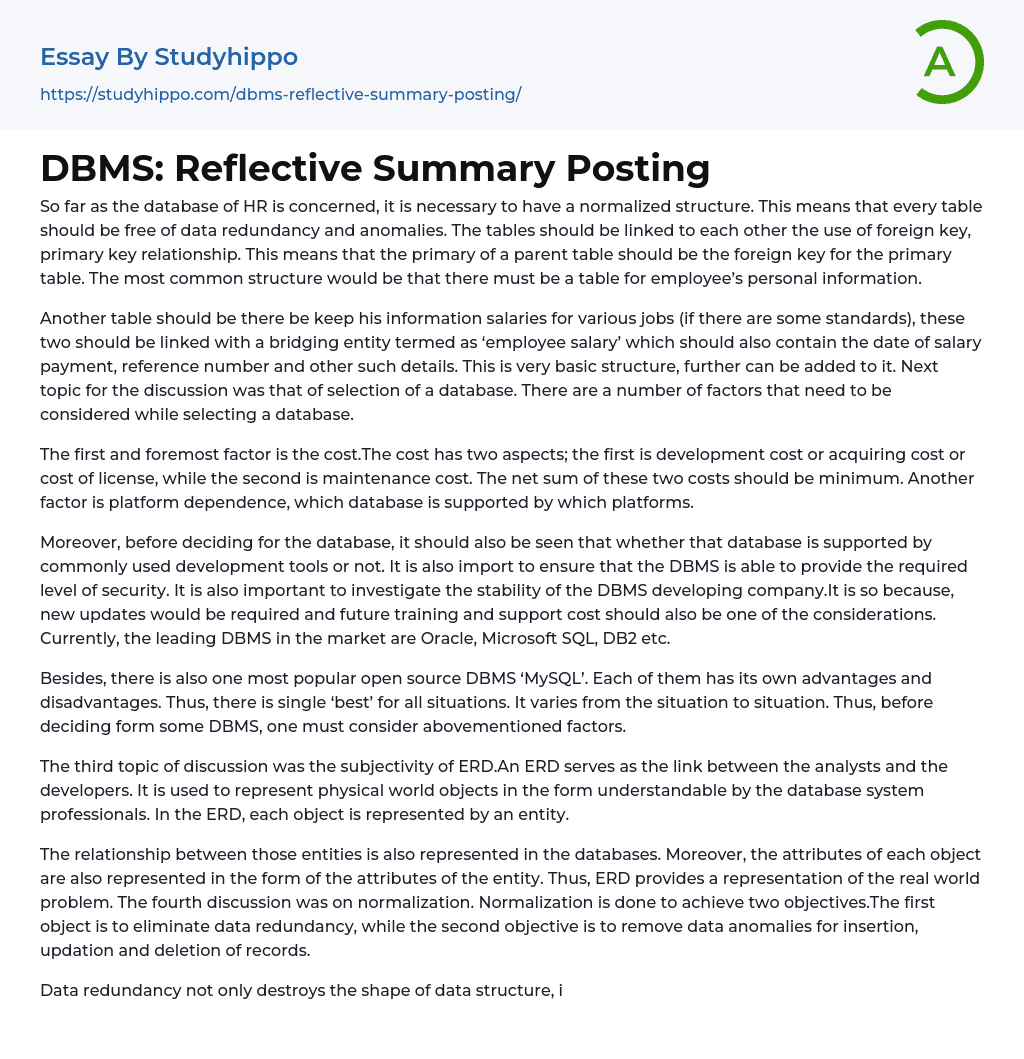For HR database, a normalized structure is essential to avoid data redundancy and anomalies. Every table should be linked through primary key and foreign key relationships. The parent table's primary key should serve as the foreign key for the child table. An employee's personal information must be stored in a separate table, which is the most commonly used structure.
In order to keep track of salary data for various positions (where standards are present), it is necessary to establish a supplementary table that can be linked with the primary one by means of an "employee salary" entity. The latter should feature information on payment dates, reference numbers, and other pertinent particulars. This framework can be easily enlarged as deemed appropriate. Another subject under consideration was the choice of database which involves several considerations in the decision-making process.
The primary consideration is the
...expense, which comprises two parts: development/acquisition/license cost and maintenance cost. The total of these two expenses should be as low as possible. Furthermore, platform dependence is a crucial factor in determining which databases are supported by different platforms.
Before selecting a database, it is crucial to ensure that it is supported by commonly used development tools and can offer adequate security. Additionally, investigating the stability of the DBMS developing company is important as future updates, training, and support costs should also be considered. The top DBMS in the market currently include Oracle, Microsoft SQL, and DB2.
Aside from MySQL, there are various other open source DBMS alternatives that possess distinctive pros and cons. Consequently, there is no definitive "top" choice applicable to all circumstances; the ideal selection hinges on the particular context. It is crucial to thoughtfully
contemplate the aforementioned factors prior to choosing a DBMS.
The ERD's subjectivity was the third discussion topic. Analysts and developers use it to link and represent physical world objects in a way that database professionals can understand. Entities represent each object within the ERD.
The databases represent the relationship between the entities and the attributes of each object are shown as the entity's attributes. This representation in the form of an ERD is a reflection of the real world problem. Normalization aims to achieve two objectives, namely, removing data redundancy and eliminating data anomalies during record insertion, updation, and deletion.
Data redundancy can cause harm to both the shape of data structure and the weight of the database. It can also result in complications and malfunctions during data insertion, updation, deletion, and report generation due to inconsistent data structure. Normalization offers a range of benefits and drawbacks. Primarily, it unifies the database and guarantees accurate representation of business logic in diagrammatic form.
Preventing information loss and unintentional results, as well as aiding in indexing for faster searching and sorting, highlights the benefits of utilizing this approach. However, it can also be overwhelming for those new to the process. I was very engaged in this discussion.
In terms of system development life cycle, one of the most important contributions was presenting the entire subject domain. The first topic discussed was the payroll database and suggested using normalized databases for integration of all entities. The use of parent-child relationships was also recommended for organization. The second discussion focused on factors for selecting a DBMS, exploring a range of considerations to accept or reject a database management system. Lastly, the third
discussion highlights the subjectivity of ERD and provides an example using a publication to illustrate how it can represent a real-world problem.
During my recent discourse on normalization, exemplified with practical instances, I elaborated on how normalization enhances database efficiency. This entailed examining the merits and demerits of normalization, with consideration for both business and technological facets. Additionally, I chose the submissions of <please insert the name of the first person> and <please insert the name of the second person>, as they both contributed comprehensive insights to the discussed topics with outstanding consistency and extensive analysis and research.
The author praises both Alvin and Pui's writing abilities, noting that their ideas were well-articulated and supported with rationales, arguments, and practical examples. Alvin's posts were particularly impressive, as they provided comprehensive analyses from diverse perspectives. Pui also successfully communicated their ideas using strong language and a well-structured flow of ideas. The author was especially impressed by Alvin's extensive list of benefits and advantages of normalization.
The writer has displayed extensive research in their assignment, specifically when discussing the factors involved in selecting a DBMS. They covered more than just cost, providing readers with a thorough understanding of the topic. Similarly, Pui's writing was concise and straight to the point while still offering unique perspectives on the subject matter.
Pui's discussion was thorough, as evidenced by the impressive array of drawbacks regarding normalization that he covered.
- John Locke essays
- 9/11 essays
- A Good Teacher essays
- A Healthy Diet essays
- A Modest Proposal essays
- A&P essays
- Academic Achievement essays
- Achievement essays
- Achieving goals essays
- Admission essays
- Advantages And Disadvantages Of Internet essays
- Alcoholic drinks essays
- Ammonia essays
- Analytical essays
- Ancient Olympic Games essays
- APA essays
- Arabian Peninsula essays
- Argument essays
- Argumentative essays
- Art essays
- Atlantic Ocean essays
- Auto-ethnography essays
- Autobiography essays
- Ballad essays
- Batman essays
- Binge Eating essays
- Black Power Movement essays
- Blogger essays
- Body Mass Index essays
- Book I Want a Wife essays
- Boycott essays
- Breastfeeding essays
- Bulimia Nervosa essays
- Business essays
- Business Process essays
- Canterbury essays
- Carbonate essays
- Catalina de Erauso essays
- Cause and Effect essays
- Cesar Chavez essays
- Character Analysis essays
- Chemical Compound essays
- Chemical Element essays
- Chemical Substance essays
- Cherokee essays
- Cherry essays
- Childhood Obesity essays
- Chlorine essays
- Classification essays
- Cognitive Science essays




